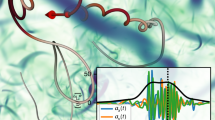Abstract
We have used direct numerical simulation results for the Eulerian velocity difference probability density function and the mean acceleration difference conditioned on the velocity difference, to explore some of the assumptions underlying the formulation of Lagrangian stochastic models for relative dispersion. We focussed on the ability of the models to quantitatively represent Richardson’s t 3-law and in particular the value of Richardson’s constant. As a result of intermittency, with decreasing spatial separation and with increasing Reynolds number these Eulerian quantities become more extreme and the model predictions for Richardson’s constant also become more extreme (larger). This is in contrast with recent numerical simulations showing that Richardson’s constant depends only weakly on Reynolds number. We conclude that, at least in the present Lagrangian stochastic modelling framework, in two-particle models (and presumably in multi-particle models) intermittency must be included explicitly in the dissipation rate as well as in the relative velocity statistics.
Similar content being viewed by others
References
Taylor, G.I.: Diffusion by continuous movements. Proc. Lond. Math. Soc. 20, 196–212 (1921)
Obukhov, A.M.: On the distribution of energy in the spectrum of turbulent flow. Izv. Akad. Nauk SSSR, Ser. Geogr. Geofiz. 5, 453–468 (1941)
Batchelor, G.K.: The application of the similarity theory of turbulence to atmospheric diffusion. Q. J. R. Meteorol. Soc. 76, 133–146 (1950)
Richardson, L.F.: Atmospheric diffusion shown on a distance-neighbour graph. Proc. R. Soc. Lond., A 110, 709–737 (1926)
Sawford, B.L.: Turbulent relative dispersion. Annu. Rev. Fluid Mech. 33, 289–317 (2001)
Ott, S., Mann, J.: An experimental investigation of the relative diffusion of particle pairs in three-dimensional turbulent flow. J. Fluid Mech. 422, 207–223 (2000)
Ishihara, T., Kaneda, Y.: Relative diffusion of a pair of fluid particles in the inertial subrange of turbulence. Phys. Fluids 14, L69–L72 (2002)
Biferale, L., Boffetta, G., Celani, A., Devenish, B.J., Lanotte, A., Toschi, F.: Lagrangian statistics of particle pairs in homogeneous isotropic turbulence. Phys. Fluids 17, 115101-1–9 (2005)
Berg, J., Luthi, B., Mann, J., Ott, S.: Backwards and forwards relative dispersion in turbulent flow: an experimental investigation. Phys. Rev., E 74, 016304-1–016304-7 (2006)
Sawford, B.L., Yeung, P.K., Hackl, J.F.: Reynolds number dependence of relative dispersion statistics in isotropic turbulence. Phys. Fluids 20, 065111-1–065111-13 (2008)
Wilson, J.D., Sawford, B.L.: Review of Lagrangian stochastic models for trajectories in the turbulent atmosphere. Boundary - Layer Meteorol. 78, 191–210 (1996)
Pope, S.B.: Lagrangian PDF methods for turbulent flows. Annu. Rev. Fluid Mech. 26, 23–63 (1994)
Thomson, D.J.: A stochastic model for the motion of particle pairs in isotropic high-Reynolds-number turbulence, and its application to the problem of concentration variance. J. Fluid Mech. 210, 113–153 (1990)
Borgas, M.S., Sawford, B.L.: A family of stochastic models for two-particle dispersion in isotropic homogeneous stationary turbulence. J. Fluid Mech. 279, 69–99 (1994)
Kurbanmuradov, O.A.: Stochastic Lagrangian models for two-particle relative dispersion in high-Reynolds number turbulence. Monte Carlo Methods Appl. 3, 37–52 (1997)
Borgas, M.S, Yeung, P.K.: Conditional fluid-particle accelerations in turbulence. Theor. Comput. Fluid Dyn. 11, 69–93 (1998)
Sawford, B.L., Yeung, P.K., Borgas, M.S.: Comparison of backwards and forwards relative dispersion in turbulence. Phys. Fluids 17, 095109-1–095109-9 (2005)
Pagnini, G.: Lagrangian stochastic models for turbulent relative dispersion based on particle pair rotation. J. Fluid Mech. 616, 357–395 (2008)
Donzis, D.A., Yeung, P.K., Sreenivasan K.R.: Dissipation and enstrophy in isotropic turbulence: resolution effects and scaling in direct numerical simulations. Phys. Fluids 20, 045108-1–045108-16 (2008)
Yeung, P.K., Pope, S.B., Sawford, B.L.: Reynolds number dependence of Lagrangian statistics in large numerical simulations of turbulence. J. Turbul. 7(N58), 1–12 (2006)
Gardiner, C.W.: Handbook of Stochastic Methods for Physics Chemistry and the Natural Sciences. Springer, Berlin (1983)
Pope, S.B.: Consistency conditions for random-walk models of turbulent dispersion. Phys. Fluids 30, 2374–2379 (1987)
Thomson, D.J.: Criteria for the selection of stochastic models of particle trajectories in turbulent flows, J. Fluid Mech. 180, 529–556 (1987)
Pope, S.B.: PDF methods for turbulent reactive flows. Prog. Energy Combust. Sci. 11, 119–192 (1985)
Sreenivasan, K.R.: On the universality of the Kolmogorov constant. Phys. Fluids 7, 2778–2784 (1995)
Gotoh, T., Fukayama, D., Nakano, T.: Velocity field statistics in homogeneous steady turbulence obtained using a high-resolution direct numerical simulation. Phys. Fluids 14, 1065–1081 (2002)
Gotoh, T., Nakano, T.: Role of pressure in turbulence. J. Stat. Phys. 113, 855–874 (2003)
Borgas, M.S., Yeung, P.K.: Relative dispersion in isotropic turbulence. Part 2. A new stochastic model with Reynolds-number dependence. J. Fluid Mech. 503, 125–160 (2004)
Meneveau, C., Sreenivasan, K.R.: Simple cascade model for fully developed turbulence. Phys. Rev. Lett. 59, 1424–1427 (1987)
Borgas, M.S.: The multifractal Lagrangian nature of turbulence. Philos. Trans. R. Soc. Lond., Ser. A 342, 379–411 (1993)
Heppe, B.M.O.: Generalized Langevin equation for relative turbulent dispersion. J. Fluid Mech. 357, 167–198 (1998)
Author information
Authors and Affiliations
Corresponding author
Rights and permissions
About this article
Cite this article
Sawford, B.L., Yeung, P.K. Conditional Relative Acceleration Statistics and Relative Dispersion Modelling. Flow Turbulence Combust 85, 345–362 (2010). https://doi.org/10.1007/s10494-010-9255-6
Received:
Accepted:
Published:
Issue Date:
DOI: https://doi.org/10.1007/s10494-010-9255-6




